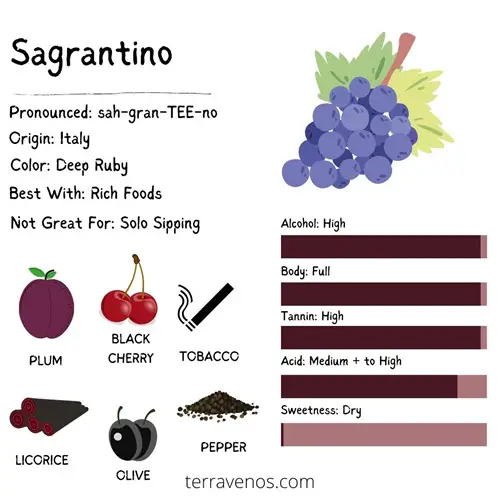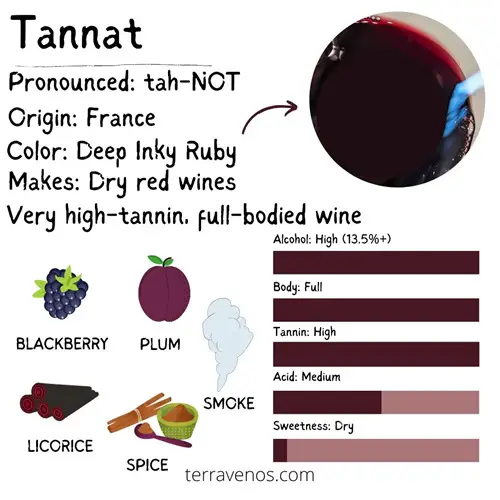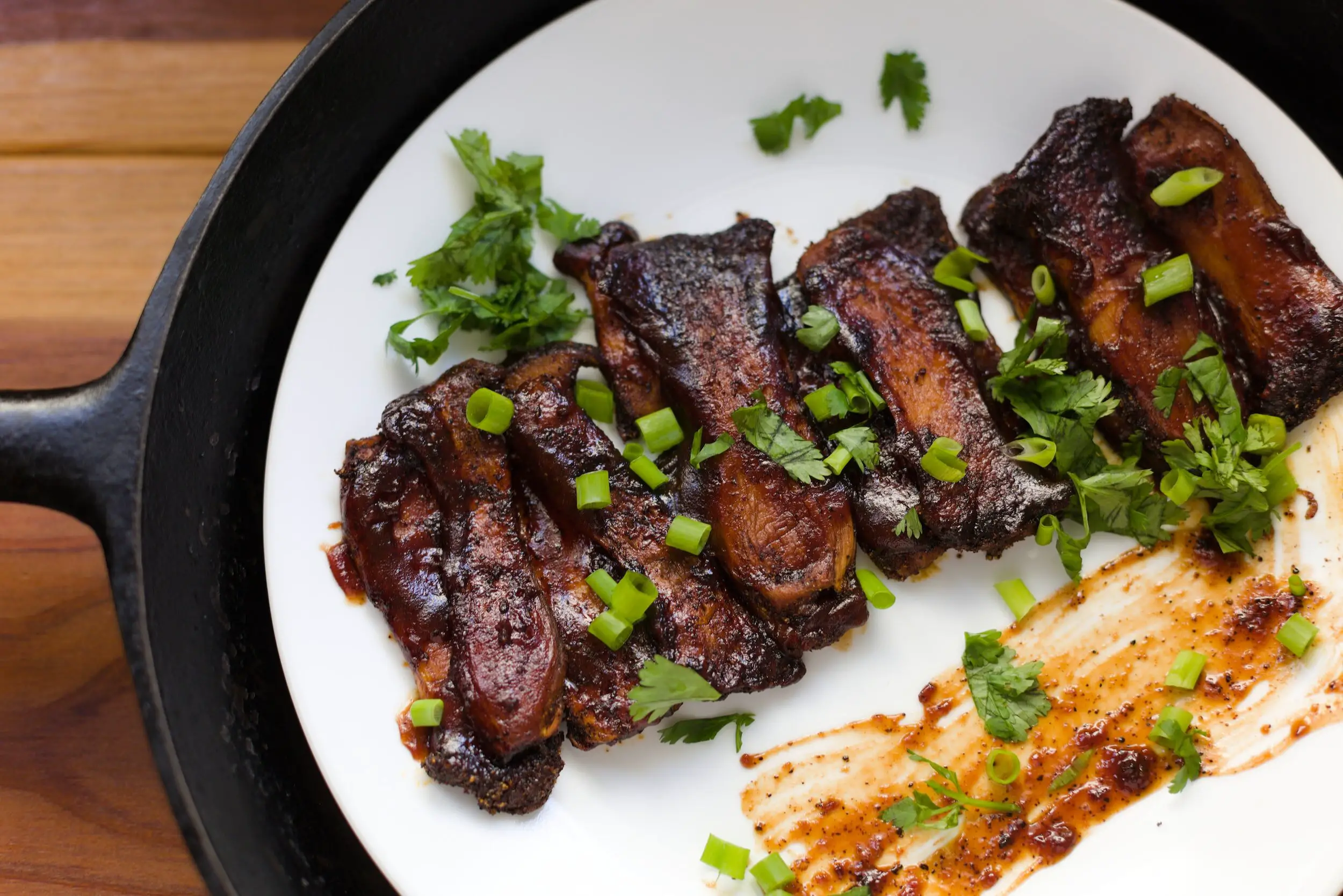| Characteristics | Sagrantino | Tannat |
|---|---|---|
| Hue | Deep purple to inky black | Dark purple to black |
| Color | Red | Red |
| Aromas | Dark berries, black plum, tobacco, peopper, olive, floral notes | Dark fruits, chocolate, black tea, licorice, smoke |
| Tannins | Very high | Very high |
| Acid | Medium to high | Medium |
| Alcohol (%) | 14-15.5% | 13-15% |
| Body | Full | Full |
| Intensity | Pronounced | Pronounced |
| Key Growing Regions | Montefalco, Italy | Southwest France (Madiran), Uruguay |
| Classic Pairings | Grilled meats, aged cheeses | Beef, game meats, hearty stews |
| Price Range | $25-$60 | $15-$40 |
When it comes to comparing big red wines, few are bigger than Sagrantino vs Tannat.
Sagrantino and Tannat are two full-bodied tannic red wines. Sagrantino has a bit higher acid than Tannat. Tannat has a smokiness and Sagrantino savoryness.
TL;DR: If you like Tannat, you’ll enjoy Sagrantino. If you love Sagrantino, you’ll like Tannat. If you love big red wines, you’ll enjoy Tannat or Sagrantino.
Sagrantino vs Tannat is an excellent comparison, and it’s a sign you’re exploring the wide, wide world of wine. Here’s what you need to know.
- Sagrantino Basics: An Italian Powerhouse
- Tannat Basics: Uruguay’s Signature Red
- Wine Comparison: Sagrantino vs. Tannat
- Sagrantino vs. Tannat: Food Pairings and Serving Temperature
- Which Is More Expensive, Sagrantino vs. Tannat?
- Which Is Better, Sagrantino or Tannat?
- Final Thoughts – Sagrantino or Tannat?
- Thirsty for More?
Sagrantino Basics: An Italian Powerhouse

Originating from the heart of Italy, Sagrantino has made a name for itself with its bold and intense personality. Mainly associated with the Umbria region, Sagrantino boasts a deep flavor profile with prominent dark fruit and savory notes and hints of chocolate and spice. Its full-bodied nature provides a robust and lingering experience. (Read more about Sagrantino wines here.)
Tannat Basics: Uruguay’s Signature Red

Tannat, from the Madiran region of southwestern France, is a powerful, tannic red wine grape that isn’t nearly as popular as some of the other big reds out there. Today, Tannat’s spiritual home is Uruguay, of all places, in a curious twist of wine fate. (Here’s a deep Tannat wines.)
You’ll find tiny pockets of Tannat grown outside of France and Uruguay from boutique producers. If you come across these wines, be sure to give them a try.
Wines from tannat are deeply colored, almost an inky-black, thanks to thick skins and small berries. Those skins leach out tannins into the wine, making for an astringent drinking experience. Tannat showcases black fruit, licorice, spice, and a smokey note.
Fun Wine Fact: The name “Tannat” derives from tannin, giving you a clue as to just how tannic this wine can be.
Wine Comparison: Sagrantino vs. Tannat
Here’s a quick side-by-side comparison covering the key styles of Sagrantino and Tannat.
Sagrantino Wine Profile
- Sweetness: Sagrantino is a dry wine.
- Alcohol: Sagrantino wines generally have a moderate to high alcohol content, ranging from around 13% to 15% ABV.
- Body: Sagrantino boasts a full-bodied and robust nature, about the same as Tannat
- Flavors: Dark fruits, chocolate, and spice dominate the flavor profile.
- Acid: Sagrantino has medium plus to high acid, similar to Tannat.
- Tannins: Sagrantino is known for its bold and grippy tannins.
- Aroma: Aromatic notes of ripe berries and hints of earthiness, it can also have a purple floral note.
Tannat Wine Profile
- Sweetness: Tannat is a dry red wine.
- Alcohol: Tannat wines generally have a moderate to high alcohol content, ranging from around 13% to 15%+ ABV.
- Body: Known for its bold body, Tannat provides a powerful and complex drinking experience.
- Tannins: Tannat has high tannins, similar to Sagrantino
- Acid: Tannat has medium acid levels, similar to or slightly less than Sagrantino
- Flavor and Aromas Intensity: Tannat will be medium plus to pronounced on the nose and palate with dark fruits, like blackberry and black plum, dark chocolate, licorice, and smoke.
Helpful Tip: I have Tannat and Sagrantino wines in my cellar, but these are not bottles I share with new-to-wine friends. They get the Moscato wines.
Are Sagrantino and Tannat Similar?
Sagrantino and Tannat are similar. They are buth full-bodied, high tannin, robust red wines with dark fruit. They both see time in oak and need to be matured to mellow them out and make them more approachable.
What Is the Difference Between Sagrantino and Tannat?
Sagrantino has slightly higher acid than Tannat. Sagrantino has distinctive peppercorn, olive, and tobacco. Tannat has spice and smoke.
Sagrantino vs. Tannat: Food Pairings and Serving Temperature

The tannin level in Sagrantino and Tannat means that you’ll want to pair these wines with protein and fat. Protein and fat molecules will bind to the tannin in the wine and lift it off your tongue, refreshing your palate. A few good options:
- Stew
- Burgers
- Tacos
- Meat lover’s pizza
- Aged hard cheeses
Personal Note: I love pairing Tannat with beef ribs.
Both Sagrantino and Tannat benefit from being served at a slightly cooler temperature. Place them in a wine cellar or refrigerator for an hour before serving to enhance the tasting experience.
Which Is More Expensive, Sagrantino vs. Tannat?
Comparing the prices of Sagrantino vs Tannat can be helpful. There’s a price overlap.
Sagrantino Cost
- Entry-level Sagrantino wines can be found in the $20 to $30 range, offering a glimpse into the varietal’s bold character.
- Premium Sagrantino selections from renowned vineyards may reach prices of $50 or more, showcasing the pinnacle of Umbrian winemaking.
Tannat Cost
- Entry-level Tannat wines are typically affordable, ranging from $15 to $20 per bottle.
- If you are looking for premium Tannat, there are higher-priced Tannat wines available. These bottles, priced around $25 to $40 or higher, offer a more complex and nuanced drinking experience.
Which Is Better, Sagrantino or Tannat?
If you like more savory notes in your red wine, Tannat is the better choice. If you prefer higher alcohol red wines with more acid and spice, then Sagrantino is the better wine.
Final Thoughts – Sagrantino or Tannat?
Both Sagrantino and Tannat offer impressive red wine options with distinctive characteristics. I recommend organizing a side-by-side tasting to appreciate the unique qualities of each fully. Grab two bottles of similarly priced Sagrantino and Tannat, invite friends over, and pour yourselves in a tasting experience that explores the bold and nuanced world of red wines.
Thirsty for More?
I’m a big believer in doing side-by-side tastings to boost your wine knowledge. Here’s how to host your own wine tasting for beginners.
Check out this post on Cabernet Sauvignon vs Merlot, another popular red wine, along with Cabernet Sauvignon vs Malbec, and Shiraz vs Merlot.
You should be able to find delicious wines at every price point. Check out this post on how to find great wines under $50.



